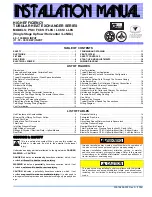
Service Information
P6136 Instruction Manual
11
Input Coupling
DC
Bandwidth
Full
3. Set the calibration generator to produce a fast-rise output with a repetition
rate of 10
m
s (100 kHz). Adjust the output amplitude to produce a 5 division
display on the oscilloscope.
4. Adjust the oscilloscope triggering for a stable display and center the
waveform on screen.
5. Note the system aberrations for comparison in step 10 below.
6. Remove the precision coax cable from the test setup.
7. Connect the P6136 probe to the oscilloscope CH 1 input.
8. Connect the probe tip through the probe-tip-to-BNC adapter and a 50
W
termination to the positive-going fast-rise output of the calibration generator.
9. Set the oscilloscope coupling to the 1 M
W
DC position.
10. Note the high-frequency aberrations in the first 30 ns (in addition to the
system aberrations noted in part 5 above).
11. If the probe aberrations are greater than
4%, 6% peak to peak, proceed to
step 12 below. If the probe aberrations are typical (
4%, 6% peak to
peak), proceed to step 18 below.
12. Disconnect the probe from the signal source and the oscilloscope.
13. Remove the plastic cover from the probe compensation box: unscrew the
compensation box retainer nut about two complete turns and lift the cover
out and up. Retighten the retainer nut.
14. Reconnect the probe to the signal source and oscilloscope.
Refer to Figure 9 for the location of adjustments to follow and Figure 10 to
identify the waveform areas affected by each adjustment.
15. Adjust R1 for the best overall flat response.
16. Adjust R3, R2, and C1 for the best corner response.
NOTE
. High-frequency adjustments affect probe bandwidth. A small overshoot on
the leading edge of the pulse may be necessary to meet the bandwidth specifica-
tion.














































